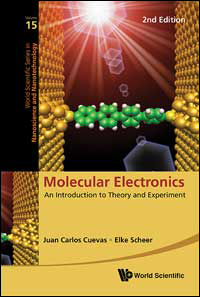Molecular Electronics Book (2nd Edition):
Description -- Contents -- Readership -- Where to order it? -- New Stuff 2nd Edition
MOLECULAR ELECTRONICS: An Introduction to Theory and Experiment (2nd Edition, July 2017) (World Scientific Series in Nanoscience and Nanotechnology - Vol. 15)

Description:
This book provides a comprehensive overview of the rapidly developing field of molecular electronics. It focuses on our present understanding of the electrical conduction in single-molecule circuits and provides a thorough introduction to the experimental techniques and theoretical concepts. It will also constitute as the first textbook-like introduction to both the experiment and theory of electronic transport through single atoms and molecules. In this sense, this publication will prove invaluable to both researchers and students interested in the field of nanoelectronics and nanoscience in general.
This second edition of Molecular Electronics has been completely revised and contains a lot of material that has not been previously published. The description of the experimental techniques in Chapters 2-3 has been updated and extended and the theoretical background (Chapters 4-10) has been fully polished and tested in several undergraduate lectures. The major changes concern Chapters 13-20 that are devoted to a review of the recent activities in Molecular Electronics. These chapters have been largely rewritten and many new topics of present interest are included in this new edition. Moreover, in an effort to make the book more useful for students, and researchers in general, we now provide a Solutions Manual containing detailed solutions of some of the problems proposed at the end of the different chapters. On the other hand, Matlab codes used to produce some of the figures of this book or to solve some of the proposed problems are now available with this new edition. All this additional material will be distributed via the website of World Scientific.
Contents:
- The Birth of Molecular Electronics
- Fabrication of Metallic Atomic-Size Contacts
- Contacting Single Molecules: Experimental Techniques
- The Scattering Approach to Phase-Coherent Transport in Nanocontacts
- Introduction to Green's Function Techniques for Systems in Equilibrium
- Green's Functions and Feynman Diagrams
- Nonequilibrium Green's Functions Formalism
- Formulas of the Electrical Current: Exploiting the Keldysh Formalism
- Electronic Structure I: Tight-Binding Approach
- Electronic Structure II: Density Functional Theory
- The Conductance of a Single Atom
- Spin-Dependent Transport in Ferromagnetic Atomic Contacts
- Coherent Transport Through Molecular Junctions I: Basic Concepts
- Coherent Transport Through Molecular Junctions II: Test-Bed Molecules
- Single-Molecule Transistors: Coulomb Blockade and Kondo Physics
- Vibrationally-Induced Inelastic Current I: Experiment
- Vibrationally-Induced Inelastic Current II: Theory
- The Hopping Regime and Biomolecular Electronics
- Beyond Electrical Conductance: Shot Noise and Thermal Transport
- Optical Properties of Current-Carrying Molecular Junctions
- What is Missing in This Book?
Download here Chapter 1: The birth of molecular electronics (pdf, 1,389 kB)
Readership:
Advanced undergraduate and graduate students in nanoscience and nanotechnology, physics, chemistry, nanoelectronics and molecular electronics.
Where to order it?
New stuff 2nd edition:
- Fully updated description of the experimental techniques.
- Theoretical background completely polished and new problems added.
- The review part of the book has been entirely revised and new topics have been added.
- Chapters on thermal transport and optical properties of molecular junctions largely expanded.
- New chapter on Biomolecular Electronics.
- Solution Manual: distributed via World Scientific website (click here).
- Matlab codes used to solve the problems are now available.
